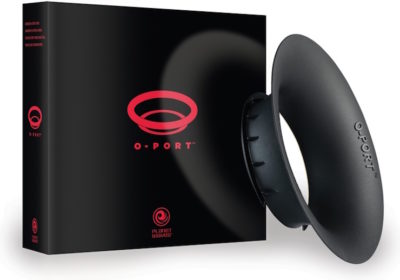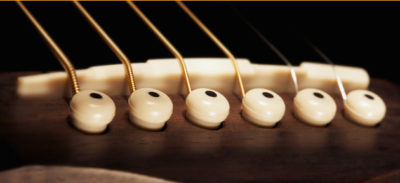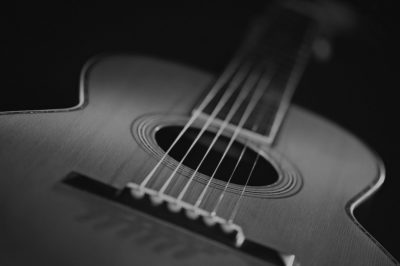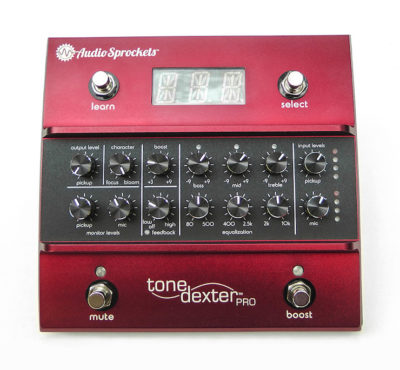5 of the Most Cost-Effective Upgrades for Recording Acoustic Guitar
Guitarists are often tweakers, dedicating hours of research and practice to get the best possible tones and comfort from their instruments.
Electric guitarists will audition countless amps, speaker cabinets, individual speakers, picks, strings, and more as they continue on the never-ending search for great tone making some of us acoustic guitar players feel left out.
There’s no need to worry about that any longer, as today we will take a look at 5 guitar modifications and accessories that can help you get more out of your studio’s acoustic guitar:
Although this probably “should” be too obvious to make the list, there are still far too many guitar players and studio owners who don’t invest enough time or money in simply restringing guitars before sessions.
It’s best to have new strings on your guitar before a session because you’ll get brighter sounds, far better intonation, and a much more comfortable-feeling guitar.
It’s also one of the most cost-effective upgrades possible. For just a handful of dollars, Installing a fresh set of strings before important sessions can often provide more of an impact than almost any mic upgrade.
If you want new strings due to intonation problems with your instrument but don’t want your guitar to sound too bright or shrill, check out D’Addario’s or Martin’s phosphor bronze strings, which have a slightly warmer sound and feel than 80/20 bronze strings straight out of the package and tend to last a bit longer.
If you are not a fan of restringing guitars often but still want the bright sound of new strings, Elixir’s “Nanoweb” coated strings will sound bright and clear for a much longer time thanks to the nanoweb coating that prevents dust, dead skin, and dirt from getting in between the windings.
If you’re restringing a guitar right before an important acoustic session, breaking them in is essential to getting all the benefits of tuning stability. This is easily done by stretching out the strings as soon as you install them, tugging firmly on them under tension from top to bottom before finishing your tuning.

The planet Waves O-Port is a non-permanent upgrade that can help breathe new life into a studio guitar.
The Planet Waves O-Port is a $20, non-permanent modification that you can install in under a minute the next time you restring your guitar.
The O-Port slips into the soundhole of your guitar and allows the whole top of the guitar to resonate more evenly.
This results in an increase in volume, low-end response, and clarity in the high end. If your guitar has a pickup, this unit will also help fight against feedback if you are playing with amplification anywhere near the instrument.
This made a huge difference for the tone of my $200 Yamaha FG700S, but I did not find it to offer as much of an advantage on an already well-balanced high-end acoustic guitar. If you think your studio acoustic sounds a bit muddy or could use some extra volume and projection, consider giving it a try.
3. Graph Tech TUSQ Nut, Saddle and Bridge Pins
Graph Tech’s TUSQ string nuts, bridge pins and saddles are are made from a high-density that enhances harmonic characteristics, lending acoustic guitars clear low end and bell-like highs, and can help bring your guitar’s tone back to life.

GraphTech’s TUSQ nuts, bridges and end pins can help improve tone, tuning stability, resonance and sustain.
These TUSQ components are made under high pressure and heat to make it incredibly durable and it will outlast most organic saddle materials.
If you have a cheaper guitar and/or if you know your guitar has a plastic nut, saddle, and even bridge pins, I would highly recommend you have them all upgraded to TUSQ. Your guitar will speak with an extra level of clarity and shimmer that just cannot be properly reproduced with thin plastic guitar parts.
While I am a huge fan of the TUSQ line, if your guitar already has a bone nut, I might recommend you keep it. Although inconsistent in quality, a good bone nut can sound really balanced and warm.
One of the lesser-known pieces of gear on this list, the Jimmy Clip is possibly one of the most useful devices for frustrated acoustic guitar players.
Hopefully, you’ve never noticed a high, “pinging” sound coming from your acoustic guitar, but if you have, then you are hearing residual harmonics ringing out between the nut and the tuners of your guitar. This sound will be much more present in a recording studio and can really ruin a good take quickly.
If you want to hear this kind of acoustic artifact for yourself, put your ear by the nut of your guitar and strum an E Major chord as loudly as you can. Mute the strings quickly and notice the residual sympathetic vibrations coming from the strings above the nut.
For years, many producers and engineers have put tape or foam over the strings above the nut to cut out these pestering sounds, and the Jimmy Clip was born out of a desire to tighten up one’s guitar sound without having to use tape or other makeshift devices on a high-quality studio instrument.
The Jimmy Clip can be custom-ordered with your own logo or name printed on it, and it’s a stylish quick way to get rid of these chiming sounds. Starting at $20, it’s a relatively cheap and painless mod that will keep your guitar sounding tight and looking pretty.
If this seems a tad pricey, you can always use tape, or even hair bands, but the Jimmy Clip is really quick to snap on to any guitar before a session.
5. Fishman Aura System or Audio Sprockets ToneDexter
While electric guitarists have access to a whole range of amp and pedal modelling tools like the Kemper Profiling Amp, it often seems like acoustic guitar players are left in the water, right?
Fortunately, there actually are actually a couple of great tools available for for acoustic guitarists who want to drastically alter the sound of their built-in pickup.
The Fishman Aura and Audio Sprockets ToneDexter cater to the acoustic guitarist who hates the sound of their piezo pickups.(And I have yet to meet anyone who actually enjoys the often nasally and harsh sounds of piezo pickups.)
Fishman’s system employs what they call their “Aura Acoustic Imaging” technology. To develop this system, the company brought over 700 guitars to a pro recording studio and recorded each one with a range of microphones, while also taking the signal from that guitar’s pickup to measure the difference.
The Aura system then takes these audio “images” and makes it so when you take that guitar and utilize the system, the pickup will now sound like the mic’d sound of the guitar. I was very skeptical when I first heard about the Aura system, but after trying it, I was blown away by how accurate some of the images are to the mics that the image is based on.
Fishman makes a couple of pickups that utilize the Aura technology as well as two stompboxes, allowing you to save images for a variety of acoustic guitars and switch between them seamlessly.
At Winter NAMM this year, I was also introduced to Audio Sprockets, a Kickstarter funded company, that has recently released their ToneDexter pedal. This system allows you to make your own “images” of your guitar using its built-in microphone input and 1/4” inputs. It can also be adapted to use with pickups on violins, cellos, or other string instruments and want to get a variety of mic’d sound with a single pickup on any acoustic instrument.
Unlike the other acoustic upgrades on this list, the ToneDexer is a real investment, retailing for $895. The Fishman acoustic modeling system is quite a bit less expensive, but also a substantial buy at $269 for the Aura Sixteen pedal.
Both are quite revolutionary products for acoustic guitar players, and have as much potential for creative application in the studio as amp modelers have long had for electric players.
I hope this list has been helpful for and introduced you to a few easy and interesting mods and accessories that will improve the results of your next acoustic recording session. If you have any favorite acoustic guitar mods or tricks, please let us know in the comments below!
Now, go out and rock out on your upgraded acoustic guitar! Because practice is the one modification to your guitar tone that trumps all the others.
Please note: When you buy products through links on this page, we may earn an affiliate commission.









